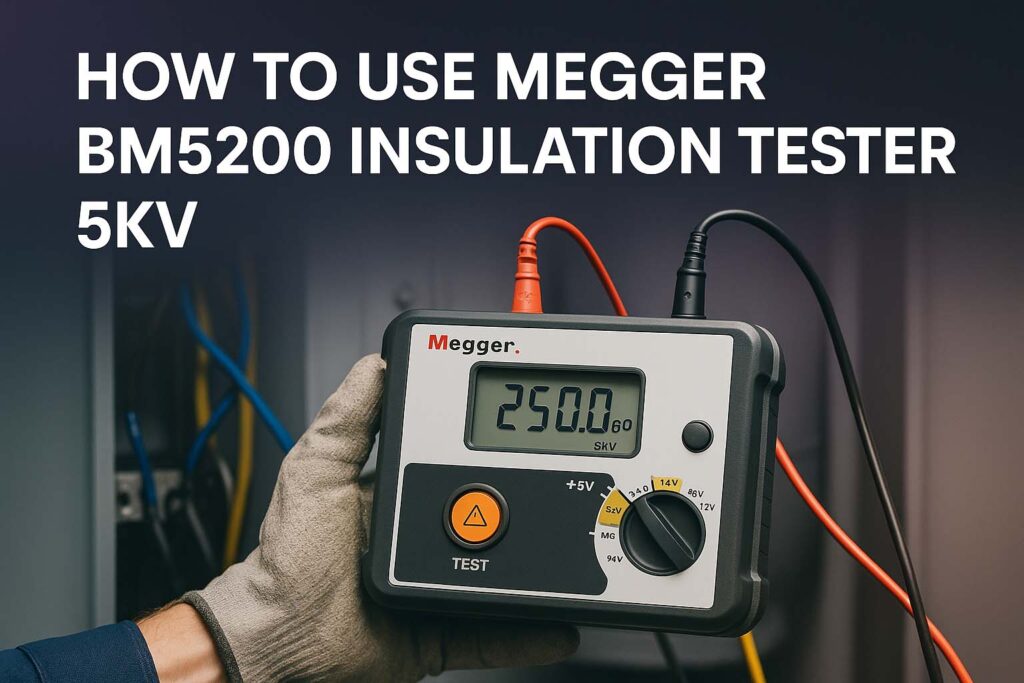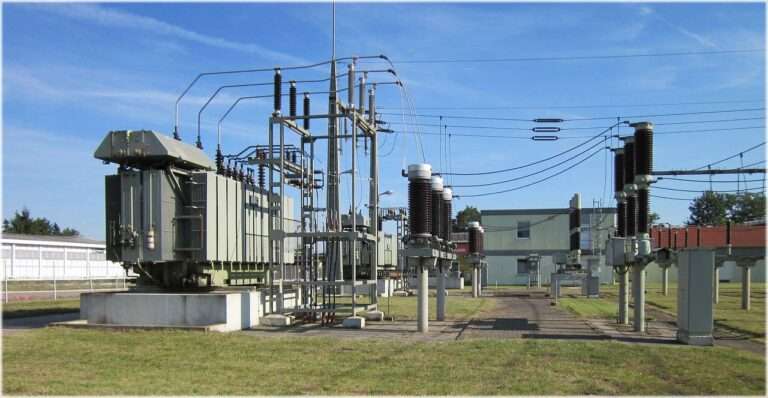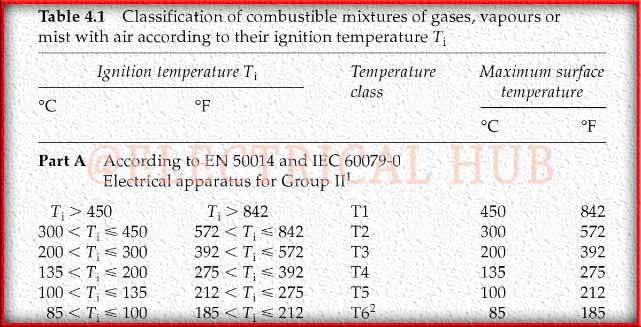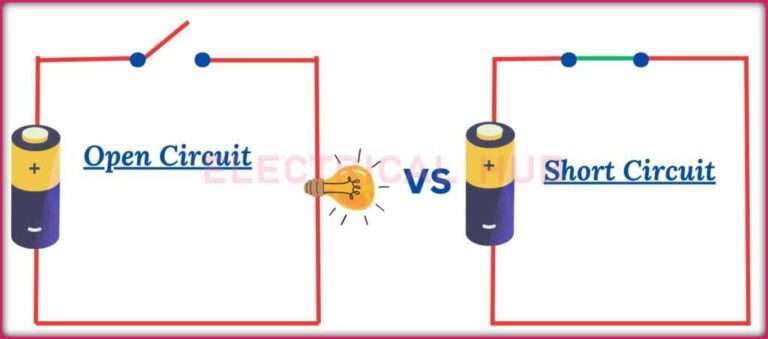How to Use Megger BM5200 Insulation Tester 5kV
The BM5200 insulation tester by Megger is a reliable and rugged device used for high-voltage insulation resistance testing. It’s an essential tool for electrical professionals working in industries like power generation, transmission, and large-scale manufacturing. This 5kV insulation tester ensures electrical equipment safety and long-term reliability by measuring insulation resistance under high voltage. In this guide, we’ll explore everything you need to know about using the Megger BM5200 insulation tester, from setup to advanced test procedures, in a clear and practical way.

What is the BM5200 Insulation Tester?
The BM5200 insulation tester is a handheld, battery-operated insulation resistance tester. It provides test voltages of 250V, 500V, 1000V, 2500V, and 5000V. The tester is designed to evaluate insulation resistance up to 100 GΩ, making it ideal for testing motors, transformers, cables, and switchgear.
It’s commonly used in preventive maintenance, commissioning of electrical equipment, and insulation condition monitoring. Its robust design allows it to withstand harsh site conditions, and the large backlit display makes readings easy to view even in poor lighting.
Know more about What is Difference Between Megger and Insulation Tester
Key specifications of the BM5200 insulation tester are shown below:
| Parameter | Value |
|---|---|
| Test Voltage | 250V to 5000V |
| Max Insulation Resistance | 100 GΩ |
| Short Circuit Current | 1.5 mA |
| Power Supply | 8 x AA batteries |
| Display | Backlit digital display |
| Timer Function | Yes (adjustable) |
| Safety Rating | CAT IV 600V |
Safety Precautions Before Using BM5200 Insulation Tester
Before using the BM5200 insulation tester, it’s important to follow these safety steps:
- Always discharge the equipment under test.
- Confirm that the circuit is de-energized.
- Use personal protective equipment (PPE).
- Avoid using the tester in wet or humid environments.
- Check the condition of test leads and insulation.
These precautions protect both the equipment and the user from unexpected electrical hazards.
How to Set Up the BM5200 Insulation Tester
The setup process is simple but must be done correctly for accurate results.
- Insert fresh AA batteries in the compartment.
- Attach the red and black test leads to the proper terminals.
- Select the required test voltage using the selector switch.
- Press the “Test” button to verify functionality.
The Megger BM5200 will power on and display initial readings on the screen. You’re now ready to test insulation resistance.
Know more about Best Megger Insulation Tester 10kV
Step-by-Step Guide to Use the BM5200 Insulation Tester
Using the BM5200 insulation tester requires following a standard procedure:
- Disconnect Power: Ensure that the system or device under test is turned off and completely de-energized.
- Discharge Capacitive Charge: Use a grounding rod or discharge probe to remove residual voltage.
- Connect Test Leads: Attach the red test lead to the conductor and the black test lead to the ground.
- Select Test Voltage: Choose an appropriate voltage based on the equipment rating (e.g., 1000V for low-voltage motors, 5kV for HV cables).
- Press Test Button: Start the insulation test by pressing the button. The timer will activate and begin the reading.
- Observe Display: The reading will stabilize within seconds. Note the resistance in GΩ or MΩ.
- Stop the Test: Release the button. The device will automatically discharge any voltage remaining in the system.
Always compare the result with manufacturer-recommended values or insulation resistance standards like IEEE 43 or IEC 60034.
BM5200 Insulation Tester Voltage Settings and Applications
Different test voltages are used for various types of electrical equipment. Here’s a quick reference:
| Equipment Type | Recommended Test Voltage | Minimum Acceptable Insulation Resistance |
|---|---|---|
| Low Voltage Motors | 500V – 1000V | >1 MΩ per kV of operating voltage |
| HV Motors & Generators | 2500V – 5000V | >100 MΩ typically |
| Power Transformers | 5000V | >200 MΩ (based on winding rating) |
| Power Cables | 2500V – 5000V | Depends on length and installation |
Choosing the correct voltage is critical. Using a voltage too high can damage the insulation of low-rated devices. Too low a voltage may not stress the insulation enough to detect potential issues.
Know more about How to Use Megger Insulation Tester 5000V
Understanding the Display Readings
The BM5200 insulation tester offers intuitive results on its screen. Key indicators include:
- R Value: This is your insulation resistance reading.
- Voltage Applied: Confirms the actual test voltage.
- Elapsed Time: Shows the test duration.
- Battery Status: Ensures uninterrupted testing.
- Warning Symbols: Alerts for voltage presence or lead connection errors.
Make sure to let the reading stabilize for at least 30 seconds, especially in longer cable runs or high-capacitance equipment.
Advantages of Using BM5200 Insulation Tester
Using the BM5200 insulation tester offers several key advantages:
- Accurate Readings: High-precision resistance measurement up to 100 GΩ.
- Multi-voltage Testing: Suitable for low and high-voltage equipment.
- Safety Features: Built-in discharge, high-voltage warning, and CAT IV protection.
- Portability: Lightweight and easy to carry in the field.
- Timer Function: Allows timed insulation tests for DAR or PI ratio.
Technicians who perform regular maintenance on motors, cables, or transformers will benefit from its reliable performance and ease of use.
Know more about How to Use Megger Insulation Tester 1000V
Troubleshooting with BM5200 Insulation Tester
The BM5200 can also help in identifying insulation faults in equipment. If you get unusually low resistance:
- Check for moisture or contamination in windings or cables.
- Look for thermal damage due to overloading or short circuits.
- Inspect for cracked insulation or aged materials.
- Perform Polarization Index (PI) test using timed resistance values (10 min / 1 min ratio).
These readings help in assessing insulation condition over time and determining whether maintenance or replacement is needed.
Care and Maintenance of BM5200 Insulation Tester
To keep your insulation tester in top condition:
- Store it in a clean, dry place.
- Periodically inspect test leads for cracks or wear.
- Replace batteries when the low-battery indicator appears.
- Clean the unit with a dry cloth; avoid solvents or water.
- Calibrate the device annually for consistent performance.
Proper care extends the life of the tester and ensures accurate readings every time.
Know more about How Does a Megger Insulation Tester Work
Why Choose the BM5200 Insulation Tester?
Electricians and engineers choose the BM5200 insulation tester because of its dependable accuracy, user-friendly interface, and broad application range. Whether you’re working in a power station, factory, or a remote solar site, this tool gives you reliable data for preventive maintenance. It reduces downtime, prevents electrical failures, and enhances overall safety.
Unlike cheaper models, the BM5200 delivers high-voltage insulation testing with built-in protection systems, ensuring peace of mind for professionals.
Final Thoughts
The BM5200 insulation tester is more than just a meter. It’s a diagnostic tool that helps safeguard electrical systems and protect investments. By mastering how to use it properly—selecting the right test voltage, following safety protocols, and understanding the readings—you can make better maintenance decisions and extend equipment life.
Whether you’re testing a transformer, motor, or underground cable, this high-voltage insulation tester proves its worth in every session. Choose Megger BM5200 for your insulation testing needs and experience quality, durability, and precision in one compact device.
Follow Us on Social:
Subscribe our Newsletter on Electrical Insights for latest updates from Electrical Engineering Hub
#BM5200InsulationTester, #MeggerBM5200, #InsulationResistanceTesting, #5kVTester, #ElectricalTesting, #MeggerTesting, #InsulationTesterGuide, #ElectricalMaintenance, #HighVoltageTesting, #MeggerTips, #InsulationTest, #BM5200Guide, #MeggerTutorial, #TestEquipment, #ElectricalTools






